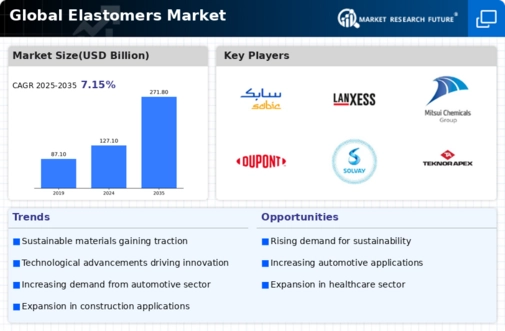Market Driver Chart
This section contains a chart illustrating the key market drivers influencing the Global Global Elastomers Market Industry. The chart visually represents the impact of rising demand from the automotive sector, technological advancements in material science, growing applications in healthcare, and sustainability initiatives. Each driver is quantified to reflect its potential contribution to market growth, providing a comprehensive overview of the factors shaping the industry landscape.
Growing Applications in Healthcare
The Global Global Elastomers Market Industry is witnessing an expansion in applications within the healthcare sector. Elastomers are increasingly utilized in medical devices, drug delivery systems, and biocompatible materials due to their flexibility, durability, and safety. For example, silicone elastomers are commonly used in implants and prosthetics, while thermoplastic elastomers are favored for their ease of processing and sterilization. As the global population ages and healthcare needs evolve, the demand for innovative medical solutions is expected to rise. This trend underscores the potential for growth in the elastomers market, aligning with the projected CAGR of 7.15% from 2025 to 2035.
Rising Demand from Automotive Sector
The Global Global Elastomers Market Industry is experiencing a surge in demand driven by the automotive sector. As manufacturers increasingly prioritize lightweight materials to enhance fuel efficiency and reduce emissions, elastomers are becoming essential in vehicle production. For instance, elastomers are utilized in tires, seals, and gaskets, contributing to improved performance and durability. The automotive industry's shift towards electric vehicles further amplifies this trend, as these vehicles require advanced materials for battery casings and insulation. This growing demand is projected to significantly impact the market, with the industry expected to reach 127.1 USD Billion by 2024.
Technological Advancements in Material Science
Technological advancements in material science are propelling the Global Global Elastomers Market Industry forward. Innovations in polymer chemistry and processing techniques are enabling the development of high-performance elastomers with enhanced properties such as heat resistance, flexibility, and chemical stability. These advancements allow for the creation of specialized elastomers tailored for various applications, including medical devices, consumer goods, and industrial components. As industries seek to improve product performance and sustainability, the demand for these advanced elastomers is likely to increase. This trend suggests a robust growth trajectory for the market, potentially reaching 271.8 USD Billion by 2035.
Sustainability Initiatives and Eco-Friendly Materials
Sustainability initiatives are increasingly influencing the Global Global Elastomers Market Industry. As consumers and manufacturers alike prioritize eco-friendly materials, the demand for bio-based and recyclable elastomers is on the rise. Companies are investing in research and development to create sustainable alternatives that minimize environmental impact while maintaining performance standards. For instance, bio-based elastomers derived from renewable resources are gaining traction in various applications, including packaging and automotive components. This shift towards sustainability is likely to reshape market dynamics, as businesses adapt to meet regulatory requirements and consumer preferences, further driving growth in the elastomers sector.
















